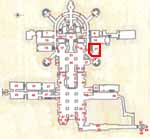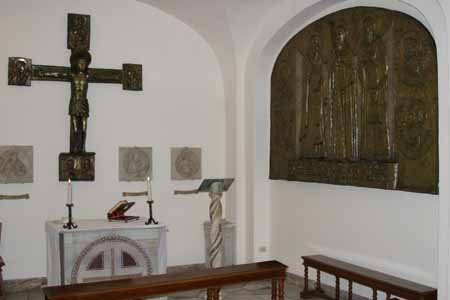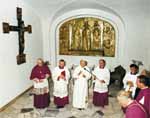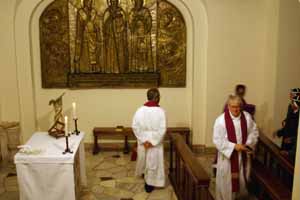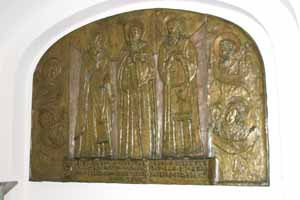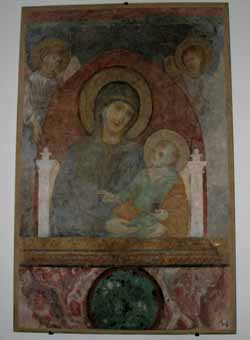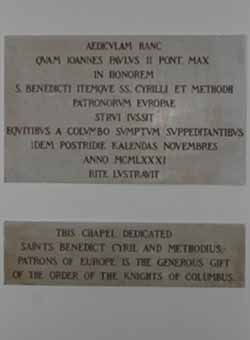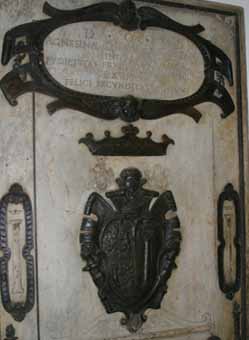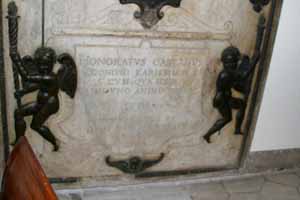| Grottoes
Vatican City Colonnade Saints Floorplan #2 |
| Altars
Monuments The History |
|
Related Links |
|
|
|
|
|
|
|
|
|
|
|
|
|
|
|
|
|
The present-day layout, which preserved the original architectural structure, followed the Apostolic Letter "Egregiae virtutis" of December 31, 1980 in which John Paul II proclaimed St Benedict, SS. Cyril and Methodius as the Patron Saints of Europe. The entrance to this chapel is wide enough for the visitors passing along the peribolos to appreciate the interior of the chapel from the outside. |
||||||||
|
The liturgical furnishing of the chapel consists, first of all, of a small altar made from ancient fragments with a 13th century Cosmatesque panel with a Greek cross inscribed in a polychrome circle. Nearby is the lectern on a spiral Cosmatesque column, originally from the tabernacle of the Holy Veil. Behind the altar is a bronze gilded crucifix by the sculptor Tommaso Gismondi. The design is inspired by the Carolingian crucifix from the 9th century that until 1550 was located in capite columnarum, i.e., on the first column of the Constantinian basilica. The living Christ is represented with a halo rather than with the crown of thorns. He is surrounded by four figures in bas-relief: to the left is the Virgin; to the right St John the Evangelist; below the support are SS Peter and Paul; above is Christ the King holding the scepter in His right hand and the globe in the left hand. The grand bronze altarpiece is by the same artist. It is located under the arch of the front wall and it represents the three Patron Saints of Europe: Benedict, with the book of the Regula; Cyril dressed in monastic robes holding a document written in Cyrillic characters; and Methodius in episcopal vestments, holding the Gospel. The bas-reliefs on the sides represent the four Evangelists with their traditional symbols. Each one holds a scroll with the initial words of their Gospels in Latin. The inscription below commemorates the dedication of the chapel to the Patron Saints of Europe. The bronze works are embellished by gilding, silver plating, patina and semi-precious stones. To the right from the altarpiece is a medieval fresco representing the Madonna with Child and Angels. The fresco comes from the old basilica where it was located in the vicinity of the Door of Death. Later it was taken to the chapel of the Madonna of Partorienti where it remained for over 3 centuries. For some time it was believed to be by the Senese school. It was restored in 1980 and is now attributed to the 13th century school of Jacopo Torriti. To the right from the entrance are the surviving fragments of the fresco on the vault of the original access corridor built by Paul V in 1617. Immured on the wall, is the elegant tombstone of Agnesina Colonna, the wife of Onorato Caetani, the general of the papal infantry in the battle of Lepanto (1571). She was buried in the basilica in 1578 and later transferred to the grottoes. The inscription in the left corner of the entrance commemorates the blessing Pope John Paul II imparted to the chapel that was realized with the support of the Order of the Knights of Columbus. Another small inscription in English commemorates the contribution of the Order.
|
||||||||
| Source: Roma Sacra The Vatican Grottoes, © Fabbrica of St. Peter's, June 2003 |
This independent website is not endorsed by or associated with the Vatican, the Fabbrica of St. Peter's, or any business organization
Contact:
stpetersbasilica@gmail.com
